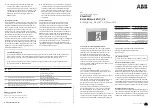
Thank you for choosing ABB product
Please read this document thoroughly before
commencing installation and retain for future
reference. Contact ABB customer service in
Australia on 1800 60 20 20 if you need any
assistance. The installation instructions were
correct at the time of print. To reflect changes in
technology and Australian standards; ABB
reserves the right to amend the instructions
without notice. Updated document can be found
on the Stanilite website.
Safety warning
In Australia and New Zealand, only licensed
electricians are permitted by law to work with
240 volt electrical installations.
Do not attempt to install or connect this product
unless you are a licensed electrician.
Turn off and isolate the electrical supply before
connecting this fitting to the building wires.
Do not touch the terminals of the terminal block
when the light fitting is energised.
The only user-serviceable part is the battery
pack. LED light source is not user-serviceable.
Do not attempt to service other parts of the
fitting as this will void the warranty.
As the installer, it is your responsibility to ensure
compliance with all relevant building and safety
codes, (ie: AS/NZS 3000, AS/NZS 2293). Refer to
This document covers
What’s inside the box
Safety warning
Main chassis and diffuser
assembly
Installation instructions
Ceiling bracket assembly
Removal instructions
Pictograph insert pack
Testing precautions
Hole plug set (6 pieces)
Troubleshooting guide
Installation manual
Warranty information
Important to note:
• This product is designed for indoor use only.
the applicable standards for data and mains
cabling installation procedures and
requirements.
Nexus LX (data cable system)
The Nexus range of emergency light fittings are
designed to be connected together into a special
communication network over a level 4 (or higher)
high speed, single twisted pair data cable. The
Nexus user and technical guide describes all you
need to know to successfully install a Nexus project.
Ask for it from your superviser, from your employer
or from your nearest ABB product supplier. The
network cabling of the building must be installed
as per the procedure detailed in the Nexus user and
technical guide. No mains or mains carrying cables
are to be connected to the data terminals or cables.
Nexus RF (wireless system)
The Nexus RF range of light fittings are designed to
communicate via a proprietary RF network, however
the electrical installation of the fittings is identical
to that of a standard non-monitored fitting.
Doc no. 29-01100_15
—
ABB Australia Pty Limited
For enquiries
ABB contact centre: 1800 60 20 20
E-mail: [email protected]
www.stanilite.com.au
© Copyright 2020 ABB. All rights reserved.
Construction sites
Continuously switching off the mains power
supply that is connected to emergency light
fittings during the construction phase of an
installation will cause these fittings to discharge
and charge their batteries many times over a
short period; this can shorten life of the battery.
ABB does not recommend such practices and
may not honour the warranty on batteries when
they are subjected to such harsh operating
conditions. Emergency light fittings are designed
to be discharge tested once every 6 months as
per AS/NZS 2293.2, subjecting the product to
repeated discharge or charge cycles is regarded
as an abuse of the fittings.
Troubleshooting guide
If you have installed and connected the fitting as per the instructions listed earlier and it does
not function correctly, use the following table as a guide to fixing the problem. Look up the
type of fault in the left column and check the possible causes from the right column.
If the fitting still does not work after checking these possible causes, contact ABB customer
service in Australia on 1800 60 20 20.
Testing precautions
Once the fitting is permanently connected to the
mains supply, a commissioning discharge test as
required in AS/NZS 2293.2 must be carried out.
You will need to allow 24 hours for the battery to
fully charge prior to conducting this test,
presently (at the time of writing), the standard
requires that fittings operate in emergency mode
for a period not less than 2 hours for their
commissioning test and for not less than 90
minutes thereafter (it is required that 6 monthly
discharge tests be carried out). You will need to
keep the records for the commissioning test and
enter them into the building emergency services
logbook or via other recording methods as
allowed by AS/NZS 2293.2.
No. Fault
Possible causes
1
LED light source and indicating LED not lit
AC supply not connected;
or
AC supply turned off;
or
Test switch damaged
2
LED light source is lit but indicating LED not lit
Test switch damaged;
or
Battery not connected or faulty
3
LED light source does not switch to emergency
mode when the test button is pressed
Test switch damaged;
or
Battery not connected or faulty
4
LED light source works momentarily on emergency
when the test button is pressed
Battery not yet charged (allow up to 24 hours)
1.
The fitting will automatically switch into
emergency mode because it has been
removed from the power supply. It will stay on
emergency until such time as the battery cut-
off threshold is reached or it is reconnected
back onto the power supply, whichever
happens first.
2.
When the fitting is reconnected to the supply,
it will need time to recharge its battery before
it will be capable of a full length discharge
again. The ability of the fitting to operate on
emergency is determined by the age, charge
level, operating temperature conditions and
environmental circumstances of the battery in
the fitting.
9
A
K
K
10
6
71
3A
9
5
70 - D - J
u
ly 2
0
20
—
I N S TA LL ATI O N M A N UA L
Stanilite®
Exit LED Quickfit®_V2
Emergency, Nexus® LX, Nexus RF




















